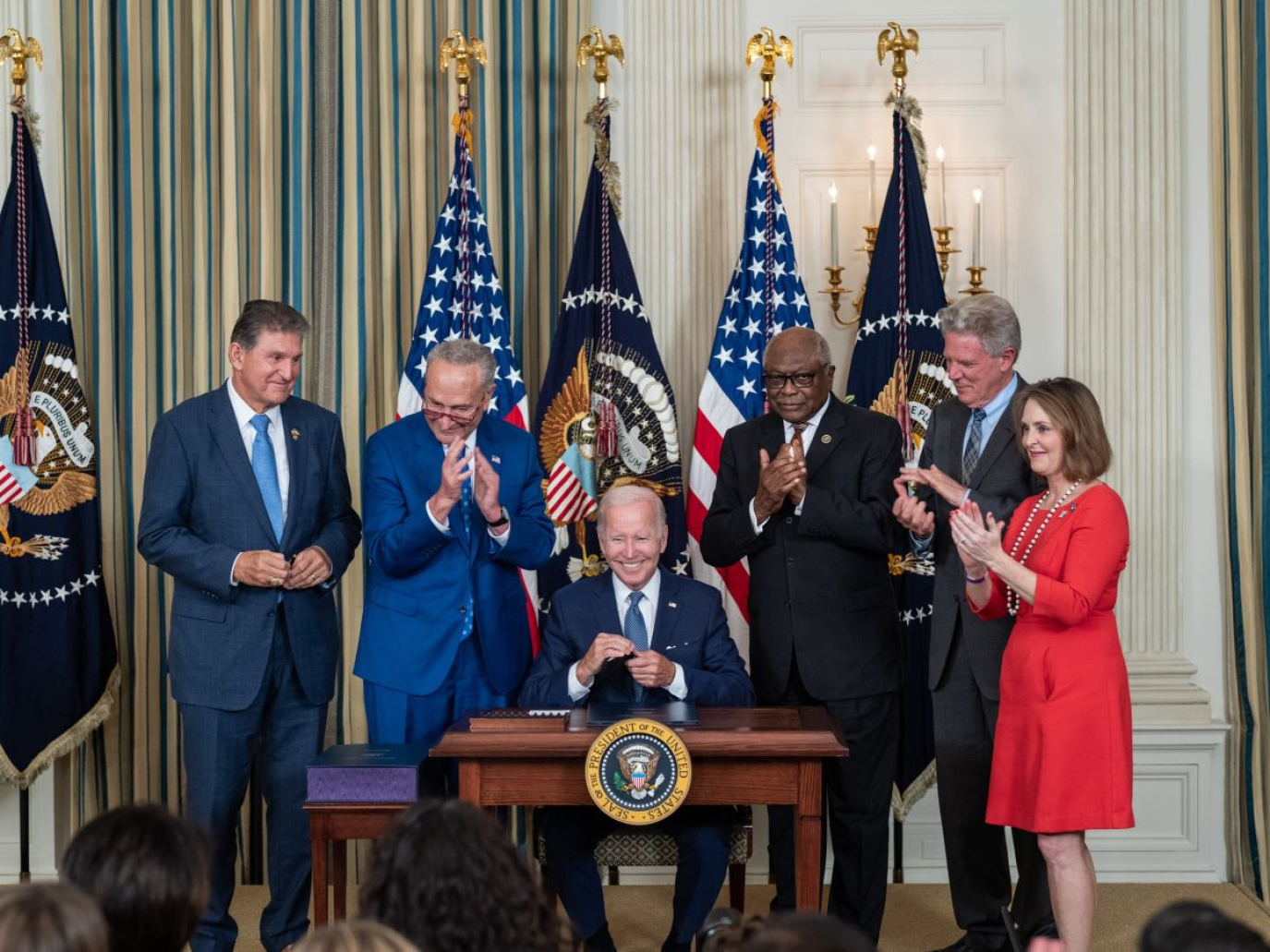In 2022, the United States, responsible for a 1.6 per cent increase in domestic greenhouse gas production over the previous year, remained one of the top seven global CO₂ emitters. Understanding how the U.S. decarbonization strategy will evolve is therefore crucial.
During Joe Biden's presidency, in addition to the re-entry into the Paris Agreement from which Trump had exited, the Inflation Reduction Act (IRA) was passed, considered the largest climate investment in American history, a milestone on the path to net zero. But what stage its implementation is at and what will be its fate after the presidential challenge between Donald Trump and Kamala Harris?
What is the Inflation Reduction Act (IRA)
The Inflation Reduction Act (IRA) is a US federal law that addresses several important economic and environmental challenges, such as reducing inflation and the national debt, combating climate change, and promoting social justice.
A document of more than 700 pages, divided into three chapters (tax, health, energy and climate), which Treasury Department, responsible for its implementation, calls ‘one of the largest investments in the US economy, energy security and climate that Congress has made in the nation's history’. Along with the Bipartisan Infrastructure Law (BIL) and the CHIPS & Science Act, the third major piece of legislation passed by the end of 2021 to improve US competitiveness, innovation, and productivity, amounting to USD 2 trillion in federal spending over the next decade.
How the IRA came about and who approved it
The IRA was passed by the 117th US Congress and enacted into law on 16 August 2022 by US President Joe Biden. Sponsored in particular by Senators Chuck Schumer and Joe Manchin, from the states of New York and West Virginia respectively, it was voted through by all Democrats in the Senate and the House, while all Republicans voted against it and subsequently voted 42 times for its repeal, although some cracks in the opposition front are beginning to emerge.
The bill was conceived based on the Build Back Better Act (BBBA), passed by the House in November 2021, which envisaged a USD 1.7 trillion spending package, almost a third of which was earmarked for climate and clean energy solutions. Although this measure did not advance in the Senate, it triggered negotiations for the subsequent historic IRA approval.
What the Inflation Reduction Act provides for and who it addresses
Summarised in numbers, the Inflation Reduction Act provides for USD 739 billion in revenue on the one hand, realised through initiatives such as tax reform, with the introduction of the minimum corporate tax rate of 15 per cent for large corporations earning more than $1 billion and other taxes, and health care cost savings through government renegotiation of prescription drug prices. On the other hand, the IRA allocates investments of USD 433 billion, of which USD 369 billion is earmarked for domestic energy production and, at the same time, for the promotion of clean energy: the aim is to reduce greenhouse gas emissions by 40 per cent by 2030 compared to 2005 levels.
The goal, as stated in the White House Guidance Book, is ‘to unlock a truly transformative change that not only favours a low-carbon energy system with American-made technology, but also offers lower energy costs and good-paying jobs, especially for disadvantaged, low-income, or pollution-prone communities’. How? Through a diverse range of tax credits, grants and loans designed to accelerate private investment in low-carbon energy projects, supply chains, electric car purchases and other initiatives.
Environmental and climate measures
Regarding tax credits, the IRA extends the Investment Tax Credit (ITC) to 30% until at least 2030, while this key measure for the development of the domestic solar photovoltaic and storage market was to be reduced to 10% in 2024 and provides for the extension of the PTC (Production Tax Credit) to solar as well as wind power. In both cases, the use of materials, products or components processed in the USA entitles the tax credit to an additional 10%.
The IRA then introduces a subsidy of up to USD 7,500 for each electric vehicle purchased, subject to certain requirements. For example, a portion of the critical minerals used in the batteries must be mined or processed in the US, or in a partner state with which there is a free trade agreement, and the final assembly of the vehicle must take place in North America.
European Union and China facing Inflation Reduction Act
The European Union greeted the Inflation Reduction Act with concern, fearing that the more protectionist regulations might favour US manufacturers at the expense of European ones. However, the macroeconomic impacts of the IRA on the EU are expected to be minimal, according to Italian climate think tank ECCO, which cites data from the Centre for Economic Policy Research. Over a 5-10 years horizon, EU income is expected to decline by 0.001%.
Against this backdrop, however, in March 2023 Von der Leyen and Biden announced the launch of the Clean Energy Incentives Dialogue, with the aim of coordinating their respective incentive schemes for renewable energy, mutually reinforcing rather than hindering each other. In the same month, China lodged a complaint against the Inflation Reduction Act with the World Trade Organisation (WTO), opening a dispute that has not yet ended.
How far has the implementation of the IRA progressed?
What are the effects of the IRA, two years after its approval? The environmental group E2 counted 334 projects in 40 states, with a total value of more than 126 billion dollars and at least 109,000 new jobs created. Further estimates were released by President Biden on the Act's second anniversary: ‘Last year, 3.4 million Americans benefited from USD 8.4 billion in tax credits to reduce the cost of clean energy and energy-efficient upgrades to their homes, while as of January 2024, more than 250,000 Americans have applied for electric vehicle incentives, totalling $1.5 billion.
Since the start of the Biden-Harris administration, companies have announced USD 900 billion in clean energy investments, including more than $265 billion in IRA-related projects, totaling more than 330,000 new jobs. ‘According to the Treasury Department, since the passage of the Inflation Reduction Act, 75 per cent of private sector investment in clean energy has flowed into counties with below-average household incomes, and clean energy investment in energy communities has doubled.’
Inflation Reduction Act: what future lies ahead with Harris or Trump?
What will be the future of the IRA, now that Joe Biden's term is coming to an end? Democratic candidate Kamala Harris comes with a solid track record of initiatives for the environment and against the oil and gas industry. Her election to the US presidency would mean a line of continuity in the policies for the ecological transition initiated by the current president, also confirmed by the choice of Tim Walz as his deputy.
On the opposite front, on the other hand, Republican candidate and former president Donald Trump has already promised to expand gas and oil extraction as much as possible and has repeatedly criticised Biden's energy-climate actions, calling them a ‘plan to enrich China’, due to the important presence of the Dragon country in the clean tech sector. Vice presidential candidate J.D. Vance, in alignment with Trump, has also repeatedly called for the elimination of the Inflation Reduction Act, or at least large parts of it. The choice of American voters on November 5th will therefore be crucial for the future of the entire planet.
This article is also available in Italian / Questo articolo è disponibile anche in italiano
Cover image: President Joe Biden signs H.R. 5376, the “Inflation Reduction Act of 2022”, Tuesday, August 16, 2022, in the State Dining Room of the White House. (Official White House Photo by Cameron Smith), via Flickr
© reproduction reserved



